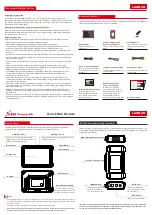
17
SETTING THE WORKING DEPTH
Setting the working depth(C) is a very important step, especially when chemical incorporation
is to be performed by the cultivator.
To set the working depth, adjust the gauge wheel up or down to get the desired shank
penetration into the soil. There are two ways to determine cultivation depth:
1.
Remove soil from around a front shank after plowing a few feet, then measure the depth of
the point of the shank to the undisturbed ground line.
2.
Measure the distance from the top of the undisturbed ground to the bottom of the 2x3 tube
the S-Tines are mounted to(B), then subtract this dimension from 19.5"(A). This value
will be the working depth(C).
Incorporation depth(D) can be estimated at one inch less than the working depth(C).
(A)-(B)=(C)
(D)=(C)-1"
IN THE FIELD
(continued)
The "S" Tine working depth(C) should be 2" to 6" deep in most normal soil conditions. (When
running deeper than 4", the optional 1 3/4" HD tine is required.)
For drying out wet soils, working depth(C) should be 1-1/2" to 2-1/2" . More than one pass
may be required in some wetter soils and the second pass may be slightly deeper than the first.
Recommended working depth(C) is no deeper than the seed is to be planted. Preparing a
seedbed too deeply may cause excessive moisture loss and poor seed germination/growth,
since the seed needs to be placed in firm moist soil. Running the machine excessively deep will
also require more horsepower.
If chemical incorporation is to be used, working depth(C) should be no more than 1" deeper
than incorporation depth(D).
GROUND
LINE
B
A
C
GAUGE WHEEL
2x3 TUBE
D






































